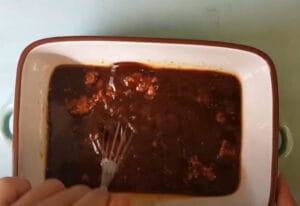Wondering about the spice in Tonkotsu Ramen? Is Tonkotsu Ramen Spicy? Uncover the secrets to achieving the perfect level of heat in your homemade ramen.
As a ramen lover, few dishes get me more excited than a piping hot bowl of tonkotsu ramen noodles. The rich, creamy pork broth bursting with umami flavor, the perfectly cooked noodles, the soft-boiled egg with its runny yolk – it’s absolute perfection in a bowl.
I still remember the first time I had real tonkotsu ramen during a trip to Japan a few years ago. As I slurped up those noodles, the intense porkiness dancing on my tongue, my eyes widened and I knew I had found my new favorite comfort food. I’ve been obsessed ever since.
Now, as a recipe developer at Food and Meal, I’m always looking for ways to recreate those iconic dishes at home. And let me tell you, authentic tonkotsu ramen is no easy feat. It requires hours of simmering pork bones to extract every last bit of collagen-rich gelatin. But the end result – that milky, lip-smacking broth – makes all the effort worthwhile.
In my newest article, I’ll be walking through my tonkotsu ramen recipe step-by-step, from making the broth to perfecting the soft-boiled egg topping. I’ll also share a few of my tips and tricks for getting restaurant-quality results, born from plenty of trial and error attempts over the years.
This hearty, soul-warming noodle soup is my pride and joy. I can’t wait to teach others how to make this Japanese classic in their own kitchens. Because nothing beats slurping up a steamy mouthful of homemade tonkotsu ramen on a cold winter’s night. It’s the ultimate comfort food, and I’m here to spread the love!
Is Tonkotsu Ramen Spicy ?
Tonkotsu ramen noodles is not inherently spicy, but it can certainly be made spicy. As I slurped up my first spoonful of rich, creamy pork bone broth bursting with umami flavor, I was enthralled. The tender noodles hugged every ounce of that luscious broth, sending my tastebuds on a joyride. But as the broth coated my tongue, I found myself craving just a touch of heat to balance out the fattiness.
I dashed over to the condiments bar and grabbed the chili garlic paste. Just a dab mixed into my bowl was all it took to achieve ramen nirvana. The subtle heat perfectly cut through the indulgent broth, allowing the complex flavors to shine. Each noodle now finished with a lingering tingle, making me crave another mouthful.
As I continued eating, beads of sweat gathered on my forehead from the accumulating spice level. But I didn’t care – I was absolutely addicted. My heart raced with excitement with each slurp, endorphins flooding my system. The once subtle heat was now a slow burn that matched my inner passion for this bowl. Tears welled up in my eyes, in part from the chilies but also from the sheer joy this ramen brought me. I didn’t want the experience to end. Alas, the last drop of broth signaled the finale. As I gazed longingly into my empty bowl, all I could think was: I can’t wait to make it spicy again next time!
Best Tonkotsu Ramen Recipes
Here are the basic steps for making non-spicy Tonkotsu Ramen. You can add chili or chili powder if you prefer.
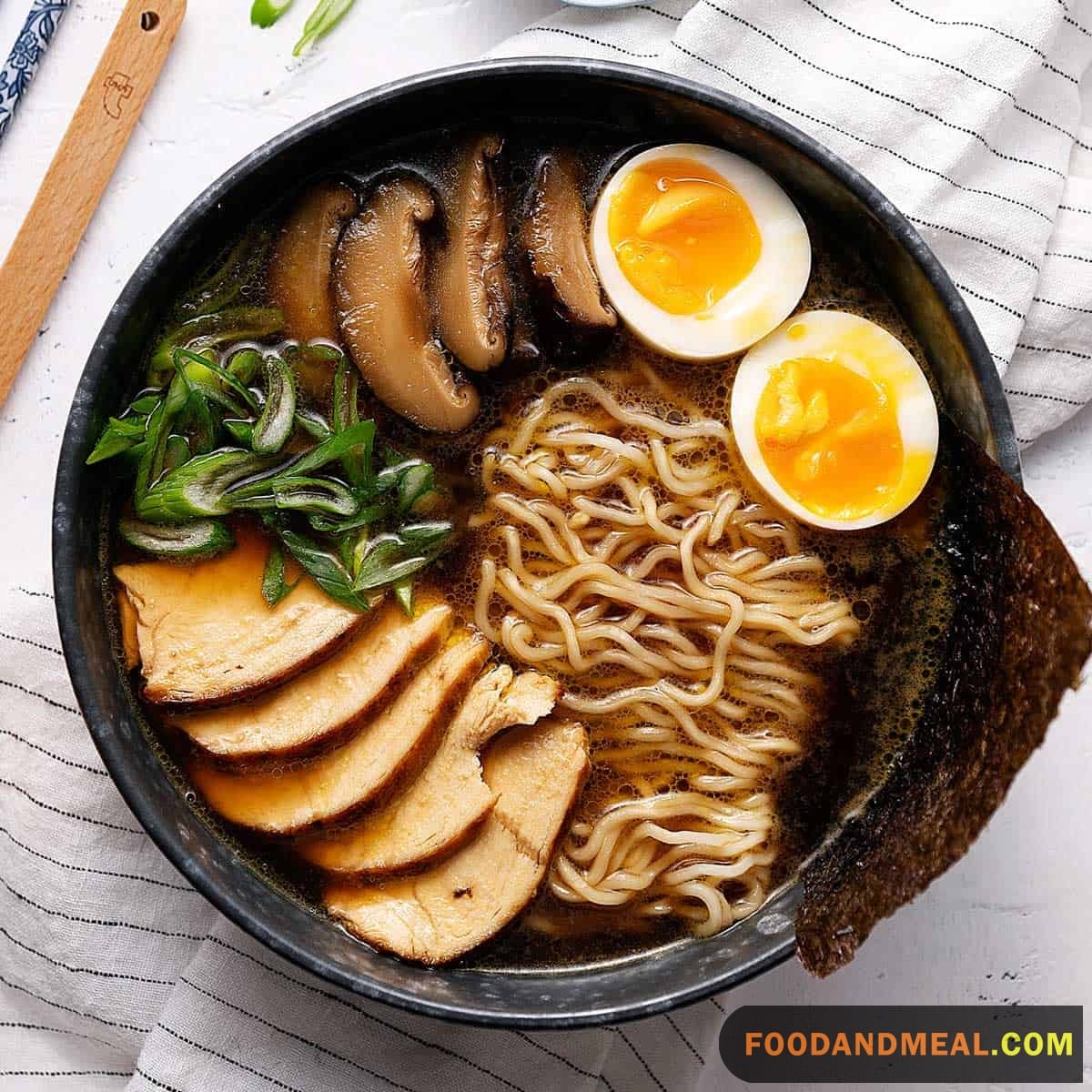
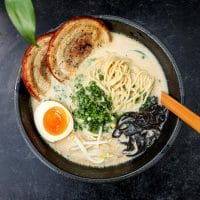
Tonkotsu Ramen
Equipment
Ingredients
For seasoning sauce
To assemble ramen
- Ramen noodles Sapporo, Hakata or Cantonese egg noodles, fresh, frozen, or dried
- 1 ½ - 2 cups basic ramen soup stock
- 1 ½ tablespoons seasoning sauce or according to taste NOTE: Use plain salt instead if you do not want soy sauce in your broth and you want a more basic flavor
- 2 thin slices chasu
- 1 slice marinated runny yolk boiled egg Scallions finely chopped Black garlic sauce (mayu)
Other optional toppings
- Fermented bamboo shoot menma, store-bought
- Nori seaweed paper, shredded
- Whole kernel corn
- Bean sprouts
- Wood ear
Instructions
- Prepare the noodles according to the packaging instructions and place a handful (or your own estimate of what would be enough for one serving) in a ramen bowl or soup bowl.

- Combine the seasoning sauce ingredients in a small bowl.

- Heat up the basic ramen soup stock to boiling and stir in the seasoning sauce (or plain salt, if preferred). Adjust the taste by adding more seasoning sauce, salt, or more broth, as desired.

- Pour this hot seasoned stock over the noodles. Top with chasu, runny yolk boiled egg, and chopped green onions. Add more toppings, as desired.

- Drizzle with mayu or black garlic oil and serve.

Video
Notes
Nutrition
© Food And Meal
This website provides approximate nutrition information for convenience and as a courtesy only. Nutrition data is gathered primarily from the Spoonacular Database, whenever available, or otherwise other online calculators.
Spicy Tonkotsu Miso Ramen from Scratch
The Foundation: For our Spicy Tonkotsu Miso Ramen, we’re talking about a creamy pork bone broth that’s been simmering for hours, infusing every drop with deep, meaty flavors. But here’s where we turn up the heat: a dollop of spicy miso paste, a concoction of white and red miso blended with douban chili paste, garlic, ginger, and a splash of mirin for that subtle sweetness.
The Noodles: Perfectly Chewy What’s a ramen without its faithful companion, the noodles? Handmade noodles are the game-changer here. We’re looking for that perfect bite—a texture that’s firm yet yielding. Achieving this requires patience and precision, from mixing bread flour with kansui to resting and rolling out the dough before cutting it into slender strands. Boil them briefly, and they’re ready to dive into the broth.
The Heat: A Symphony of Spices Now, let’s talk spice. My secret? A blend of chili powders, pastes, and oils that create layers of heat. Think togarashi, yuzu kosho, gochujang, sriracha, and sambal oelek. Each brings its own character to the bowl—some offer a slow burn, while others hit you with an immediate zing.
The Assembly: An Edible Masterpiece With our components ready, it’s time to assemble. Start with a handful of those springy noodles nestled in the bowl. Ladle the steaming, spicy broth over them, ensuring they’re submerged in that liquid gold. Now, the garnishes—soft-boiled marinated eggs, slices of chashu pork belly, nori, mushrooms, and a sprinkle of green onions for that fresh crunch.
The Result: A Bowl of Comfort and Excitement There you have it—a bowl of Spicy Tonkotsu Miso Ramen that’s both comforting and exciting. Each spoonful is a testament to the hours of preparation, a blend of rich flavors and textures that dance on the palate. And as you slurp those noodles and sip the broth, know that you’re experiencing a dish made with love and a dash of culinary flair.
Homemade Tonkotsu Ramen in a Slow Cooker
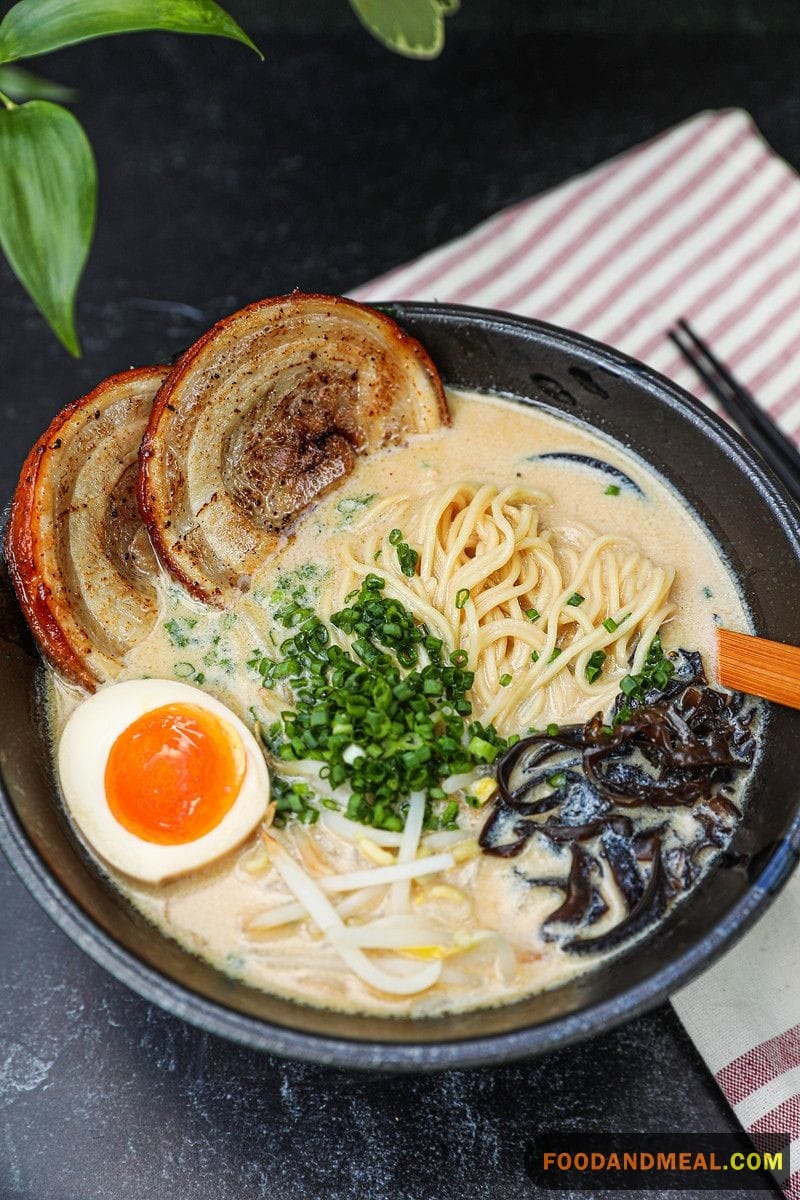
Ingredients:
- 1 lb (450g) pork belly, skinless
- 8 cups (1.9 liters) water
- 1 onion, roughly chopped
- 4 cloves garlic, minced
- 2-inch (5cm) piece of ginger, sliced
- 1/4 cup soy sauce
- 1/4 cup sake (Japanese rice wine)
- 1/4 cup mirin (Japanese sweet rice wine)
- 2 tablespoons sugar
- 1 teaspoon salt
- 1 lb (450g) fresh ramen noodles
- 4 soft-boiled eggs, halved
- 2 sheets nori (seaweed), cut into halves
- 4 green onions, sliced
- Bamboo shoots (optional)
- Menma (fermented bamboo shoots, optional)
Instructions:
- Prepare the Pork Broth:
- Place the pork belly, water, chopped onion, minced garlic, sliced ginger, soy sauce, sake, mirin, sugar, and salt in a slow cooker. Set the slow cooker to low and cook for 8-10 hours. This slow-cooked broth will infuse rich flavors into the pork.
- Cook the Ramen Noodles:
- About 30 minutes before serving, cook the fresh ramen noodles according to the package instructions. Drain and divide them into serving bowls.
- Prepare the Chashu Pork:
- Preheat your oven to 350°F (175°C). Remove the pork belly from the slow cooker and place it in an oven-safe dish. Roast it in the preheated oven for about 10-15 minutes, or until the edges are slightly crispy. Slice the pork belly thinly.
- Assemble Your Ramen:
- Ladle the rich pork broth over the cooked ramen noodles in each serving bowl. Top with sliced chashu pork, soft-boiled eggs, nori, green onions, bamboo shoots, and menma, if desired.
Tips for making Tonkotsu Ramen
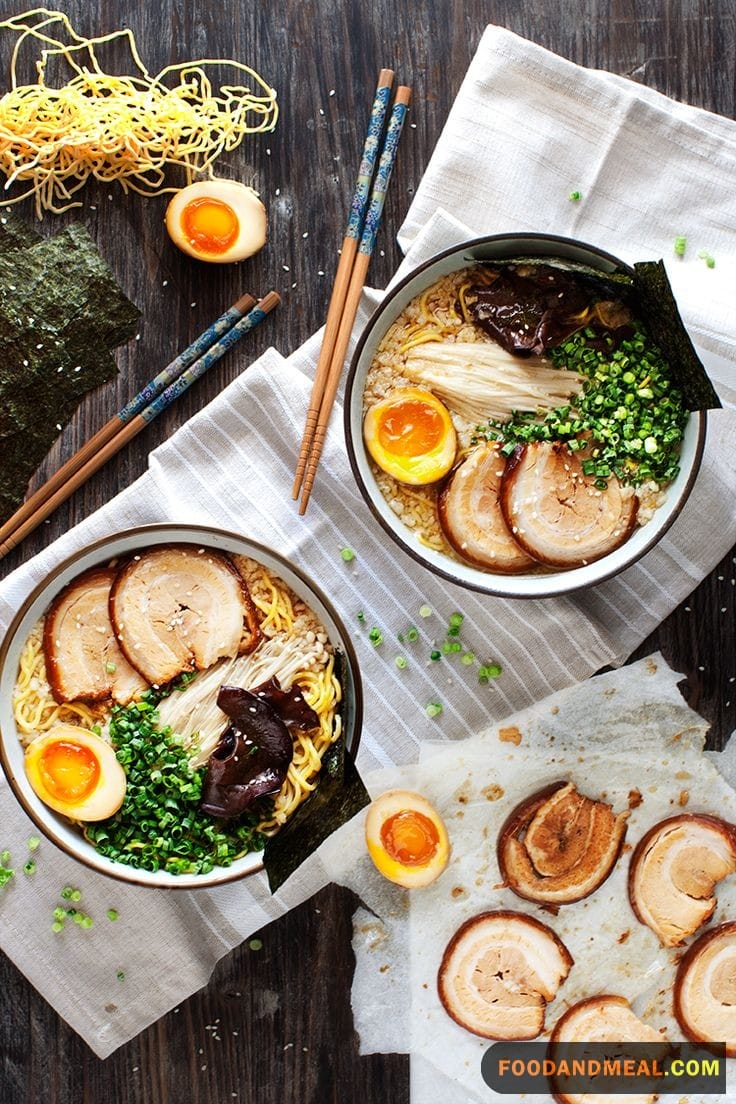
Serving Suggestions
Tonkotsu ramen noodles goes perfectly with some classic Japanese small plates like gyoza dumplings, edamame, or takoyaki. I’d also suggest pairing it with some pickled vegetables like kimchi, quick pickles, or seasoned radish strips to cut through the rich broth.
For drinks, Japanese beer or sake make excellent tonkotsu ramen companions. Iced green tea also cleanses the palate nicely between slurps of noodles.
If you want to turn your ramen noodles into more of a meal, add some extras like marinated soft boiled eggs, seared pork belly, sautéed mushrooms, baby bok choy, or scallions. Playing around with different proteins and veggies atop your piping hot bowl takes this soup to the next level!
I like to keep some furikake and sesame seeds on hand to sprinkle over my finished ramen for extra flavor and crunch too. And you can’t forget the most essential topping – naruto, the pink and white fish cake swirls that no bowl of ramen is complete without.
However you choose to garnish your homemade tonkotsu, I know it’s going to be finger-licking good. This rich, umami-packed ramen is truly the ultimate comfort food. Enjoy every last slurp!
Cooking Tips
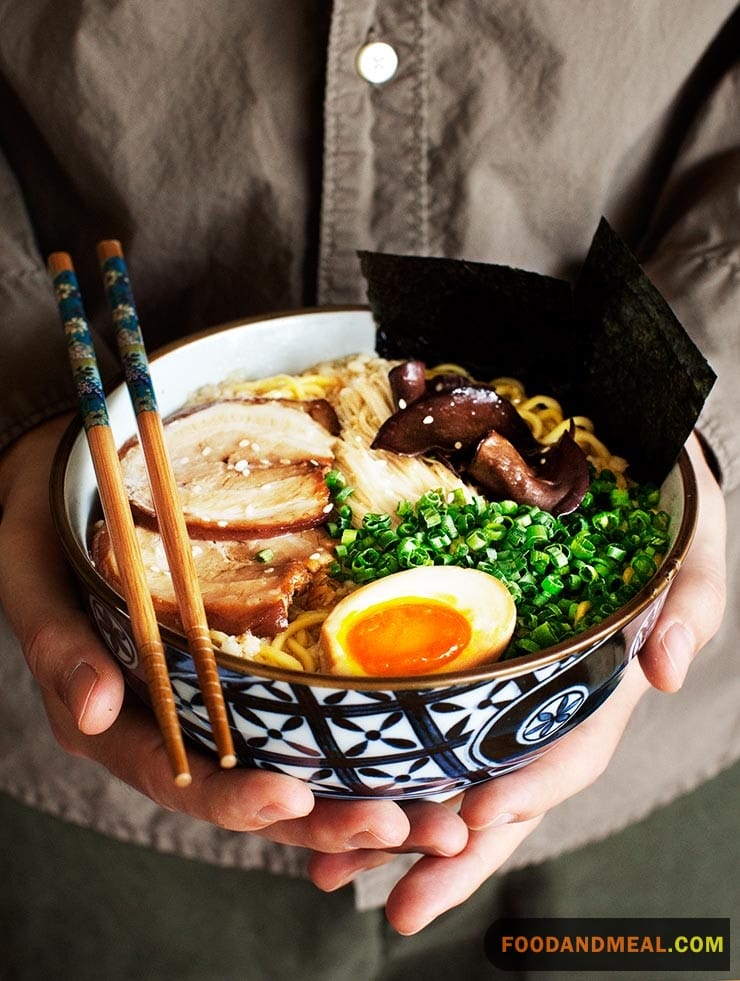
- Patience is Key: When making Tonkotsu broth, low and slow is the way to go. Allow the pork belly and broth to simmer for hours, and you’ll be rewarded with a rich and creamy result.
- Skim the Broth: While cooking the broth, be sure to skim off any impurities that rise to the surface. This will help achieve a clearer, cleaner broth.
- Adjust Seasoning: Taste your broth as it simmers and adjust the soy sauce, sugar, and salt to your preference.
- Boiling the Broth: Don’t let the broth come to a rolling boil. A gentle simmer ensures the flavors meld harmoniously.
- Skipping the Roasting Step: The oven roasting step for the chashu pork adds a lovely depth of flavor and texture. Don’t skip it.
- Overcooking the Eggs: For perfect soft-boiled eggs, follow a precise timing—usually around 6-7 minutes. Overcooking will result in hard-boiled eggs.
Top 10 FAQs about Tonkotsu Ramen
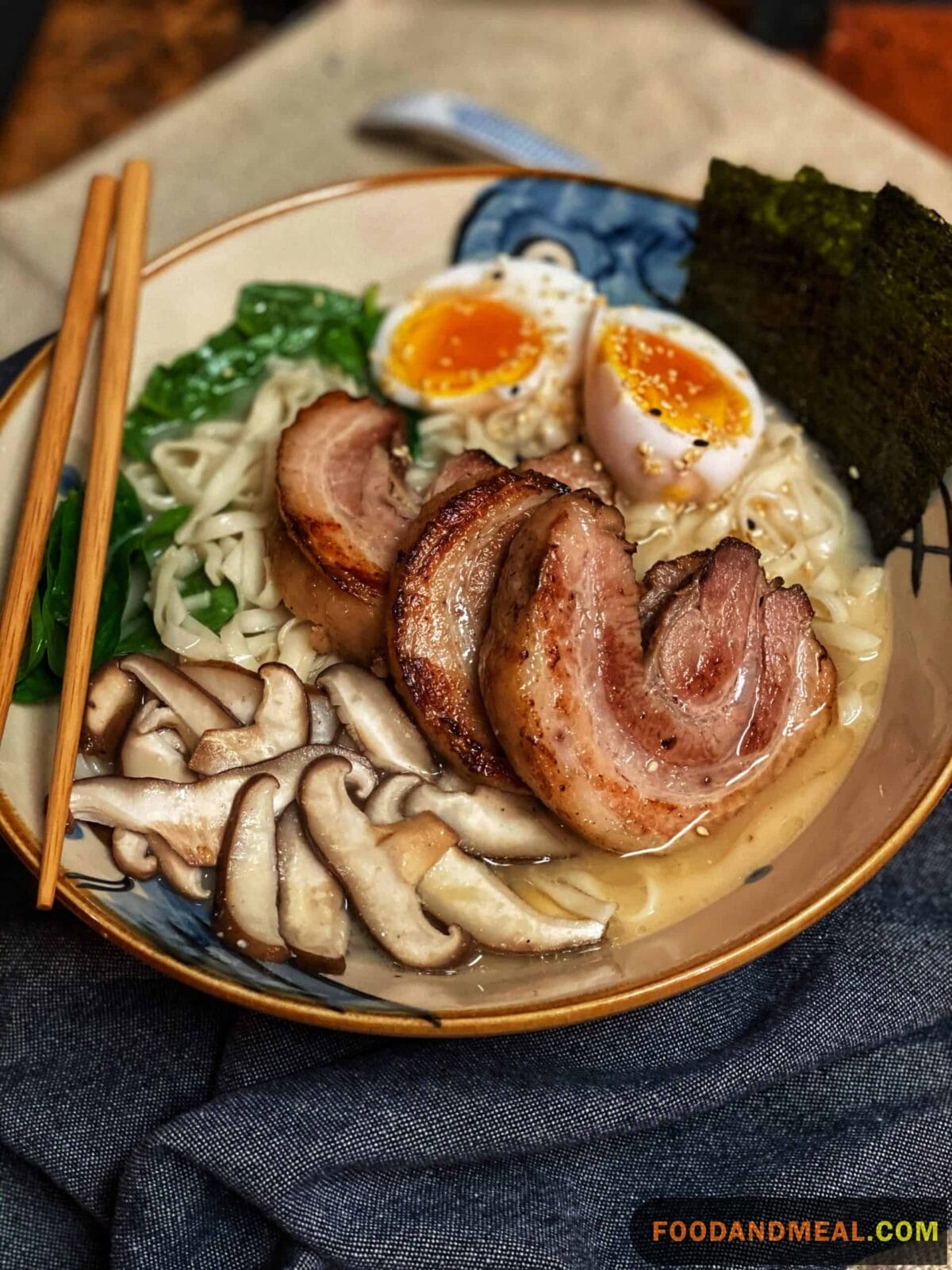
1. What do they put in Tonkotsu Ramen?
- Ramen typically includes a rich pork bone broth, fresh ramen noodles, chashu (braised pork belly or shoulder), green onions, and may also include toppings like a soft-boiled egg, seaweed, and bamboo shoots.
2. How does Tonkotsu get creamy?
- The creamy texture of Tonkotsu broth comes from simmering pork bones (usually trotters and marrow bones) for an extended period. This slow-cooking process extracts collagen and gelatin from the bones, creating a rich and velvety consistency.
3. Why is Tonkotsu Ramen spicy so high in calories?
- Ramen is calorie-dense due to its hearty pork bone broth, which contains fats and collagen. Additionally, the inclusion of pork belly, eggs, and other toppings contributes to its calorie content. It’s a robust and flavorful dish meant to be enjoyed in moderation.
4. How do you make instant Tonkotsu Ramen taste better?
- To enhance the flavor of instant Ramen, consider adding fresh ingredients such as sliced green onions, mushrooms, or a soft-boiled egg. You can also customize the broth with soy sauce, sesame oil, or chili oil for an extra kick.
5. Is Tonkotsu Ramen safe during pregnancy?
- It is generally safe to consume Tonkotsu Ramen during pregnancy, but it’s essential to ensure that the pork is thoroughly cooked. Pregnant individuals should also be mindful of the overall calorie intake and choose toppings that align with their dietary preferences and restrictions.
6. Can I make Tonkotsu Ramen spicy vegetarian or vegan?
- Yes, you can create a vegetarian or vegan version by substituting pork with plant-based ingredients and using vegetable-based broth. The key is in crafting a flavorful, umami-rich broth without meat.
7. How do I store leftover Tonkotsu Ramen?
- Store any leftovers in an airtight container in the refrigerator. Keep the broth and noodles separate to maintain the best texture. Reheat the broth and noodles gently before serving.
8. What if I can’t find fresh ramen noodles?
- If fresh ramen noodles are unavailable, you can use dried ramen noodles as a substitute. Cook them according to the package instructions.
9. Can I freeze Tonkotsu Ramen broth?
- Yes, you can freeze the broth for future use. Allow it to cool completely, then transfer it to airtight containers, leaving space for expansion. Thaw and reheat gently when ready to use.
10. Can I make Tonkotsu Ramen in advance for a special occasion?
- Absolutely. Ramen broth can be prepared in advance and stored. The final assembly with noodles and toppings can be done just before serving, making it a convenient option for special occasions.
Conclution
In closing, I hope this Tonkotsu Ramen Spicy Recipe has inspired you to try making ramen at home. While it does take some effort, the unbeatable flavor makes it all worthwhile. Once you master the technique, you’ll be whipping up this Japanese favorite again and again.
The rich broth, tender noodles, and velvety soft-boiled egg come together to create a soul-warming bowl of goodness. It’s the ultimate comfort food that transports me back to that little ramen shop in Japan every time.
If you do give this recipe a try, let me know! I’d love to hear your feedback and see photos of your homemade creations. And if you have any tips for achieving an even more intense pork flavor or a richer broth, do share as well. I’m always looking to up my tonkotsu ramen game.
Now if you’ll excuse me, all this talk of noodles has made me hungry. I think it’s time to put another batch of broth on to simmer and whip up a steaming hot bowl for myself!




